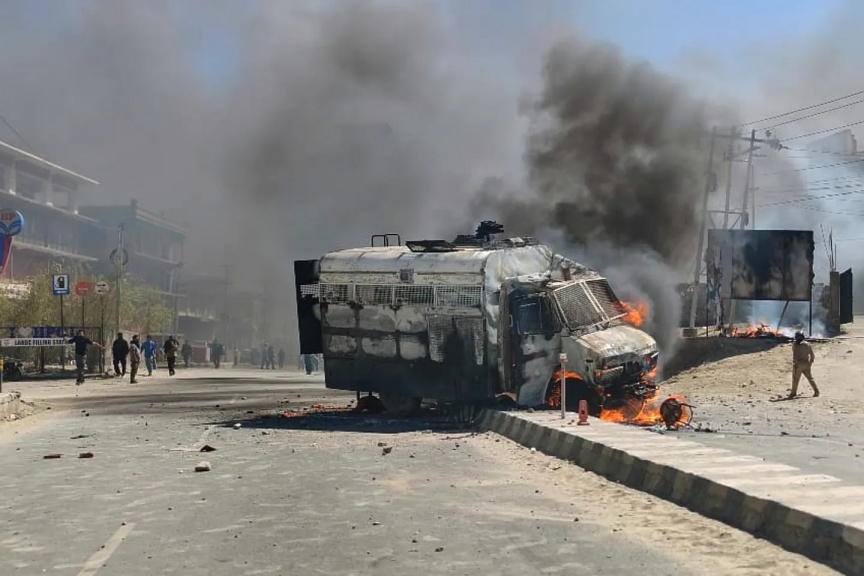
A torched police vehicle is seen near the BJP office in Leh as protesters clashed with police over Ladakh autonomy demands, on September 24, 2025. (Photo/AP)
At least five people were killed and "dozens" were wounded as police clashed with hundreds of protesters demanding greater autonomy in the Himalayan territory of Ladakh, formerly part of India-administered Kashmir, which was split from it after removing the region's statehood and abrogating its semi-autonomy in 2019.
In the main city of Leh, demonstrators torched a police vehicle and the offices of Prime Minister Narendra Modi's Bharatiya Janata Party, while officers fired tear gas and used batons to disperse crowds, police said.
"Five deaths were reported after the protests," a police officer in Leh told AFP, on condition of anonymity as he was not authorised to speak to journalists.
More than 50 people, including 20 police personnel, were wounded, a police source noted.
Demonstrations, inflammatory speech, and assemblies of more than four people were being banned to maintain peace, district administrator Romil Singh Donk said in a public notice.
Nestled between India, Pakistan, and China, the sparsely populated, high-altitude desert region is home to some 300,000 people.
Around half of Ladakh's residents are Muslim, and about 40 percent are Buddhist.
It is classed as a "Union Territory," meaning that while it elects lawmakers to the national parliament, it is governed directly by New Delhi.
While restive Indian-administered Kashmir has largely been silenced through a crackdown on any form of dissent and a slew of new laws, demands for political rights in Ladakh have intensified in recent years.
What do the protesters want?
Wednesday's demonstrations were organised in solidarity with prominent activist Sonam Wangchuk, who has been on hunger strike for two weeks.
Like Wangchuk, protesters are demanding either full statehood for Ladakh or special status that would allow the creation of elected local bodies to protect its tribal communities, land and fragile environment.
"Social unrest arises when you keep young people unemployed and deprive them of their democratic rights," said Wangchuk, who called off his fortnight-long hunger strike after the violence.
He appealed to people to avoid violence, "whatever happens".
“This is not a solution to Ladakh's problem if our youth have sorrow and pain that we are on hunger strike, then we are breaking our hunger strike from today,” he said.
Unkept promises fuel frustration
India's army maintains a large presence in Ladakh, which includes disputed border areas with China.
Troops from the two countries clashed there in 2020, leaving at least 20 Indian and four Chinese soldiers dead.
New Delhi has yet to fulfil its promise to include Ladakh in the "Sixth Schedule" of India's constitution, which allows people to make their own laws and policies.
"There is no platform for democracy here today," Wangchuk said. "Even the Sixth Schedule, which was promised and declared, has not been implemented."
India's home ministry has been in talks with Ladakh's leaders since 2023 and has said it is looking into their demands.
The next round of discussions is scheduled for October 6.
___
Source: TRT